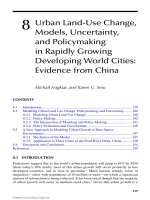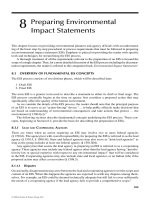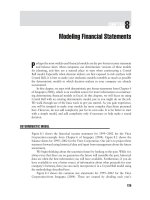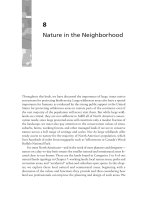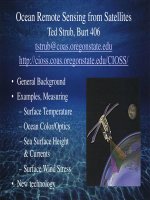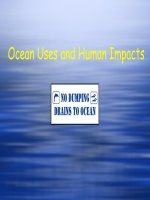Geography and Oceanography - Chapter 8 pptx
Bạn đang xem bản rút gọn của tài liệu. Xem và tải ngay bản đầy đủ của tài liệu tại đây (1.66 MB, 30 trang )
Origin and Distribution of
Marine Sediments
What’s all that squishy muck at
the bottom of the ocean?
What can we learn from it?
Marine Sediments are:
✦
Particles of various sizes derived from
a variety of sources that are deposited
on the ocean floor
✦
A vast “library” recording geologic,
oceanographic and climatic conditions
✦
Remarkably complete compared to land
Where do these come from?
✦
Inputs are:
rivers
atmosphere
surface waters
volcanoes (both on land and submarine)
deep ocean water
outer space
Classifications
✦
By Size
Clay Silt Sand Pebble Cobble
0.001 mm 1 mm 100 mm
✦
Effects of water velocity on transport: rivers
and near-shore vs open ocean
Sediment Transport
Fluid velocity
determines the
size of the
particles that
can be moved
Size Sorting
Classifications
✦
By Origin
Terrigenous from land
Biogenous from life in the oceans
Hydrogenous precipitated from water
Cosmogenous extraterrestrial
Terrigenous sediments
(from land)
✦
Rivers
✦
Winds (eolian)
✦
Glaciers (ice-rafted debris, IRD)
✦
Turbidites
✦
Sea level changes
River sediment loads
(units 10
6
tons/yr)
Glacial (Ice-rafted debris)
Turbidites
◆
Rapidly-accumulated terrestrial sediments
◆
Earthquake-triggered submarine
avalanches
◆
High velocity (~50 mph!), erosive events
◆
Good examples preserved on Mary’s Peak
Turbidites
(submarine avalanches)
Sea Level Changes
Biogenous sediments
(from living things)
✦
Calcareous (CaCO
3
)
Foraminifera animals
Coccolithophores plants
✦
Siliceous (SiO
2
)
Radiolaria animals
Diatoms plants
µm = micron = millionth of a meter!
µm = micron = millionth of a meter!
µm = micron = millionth of a meter!
µm = micron = millionth of a meter!
Productivity =
skeletons and soft tissue
◆
Accumulation depends on production
and preservation
◆
SiO
2
is preserved everywhere
◆
CaCO
3
is variable, depending on P, T,
pH
Carbonate Compensation Depth
Carbonate Compensation Depth
✦
The depth at which carbonate input
from the surface waters is balanced by
dissolution in corrosive deep waters
✦
In today’s ocean this depth (CCD)
varies between 3 km (polar) and 5 km
(tropical)
✦
Thus, accumulation rates vary a lot!
Accumulation Rates for Oozes
✦
Productivity
reproduction of planktonic organisms
✦
Preservation
silica dissolves only very slowly
calcium carbonate varies with depth
✦
Rates
are variable: <1 to 15mm/1000 yr
Coastal waters are often highly productive, with
abundant planktonic organisms thriving in the
surface waters.
Why then are biogenous oozes rarely found
nearshore??
the large input of terrigenous
sediment to the continental margin
overwhelms the biogenous component
in the sediment.
Hydrogenous (from sea water)
✦
Metalliferous sediments at spreading
ridges “black smokers”
✦
Manganese nodules
✦
Evaporites Salt deposits
